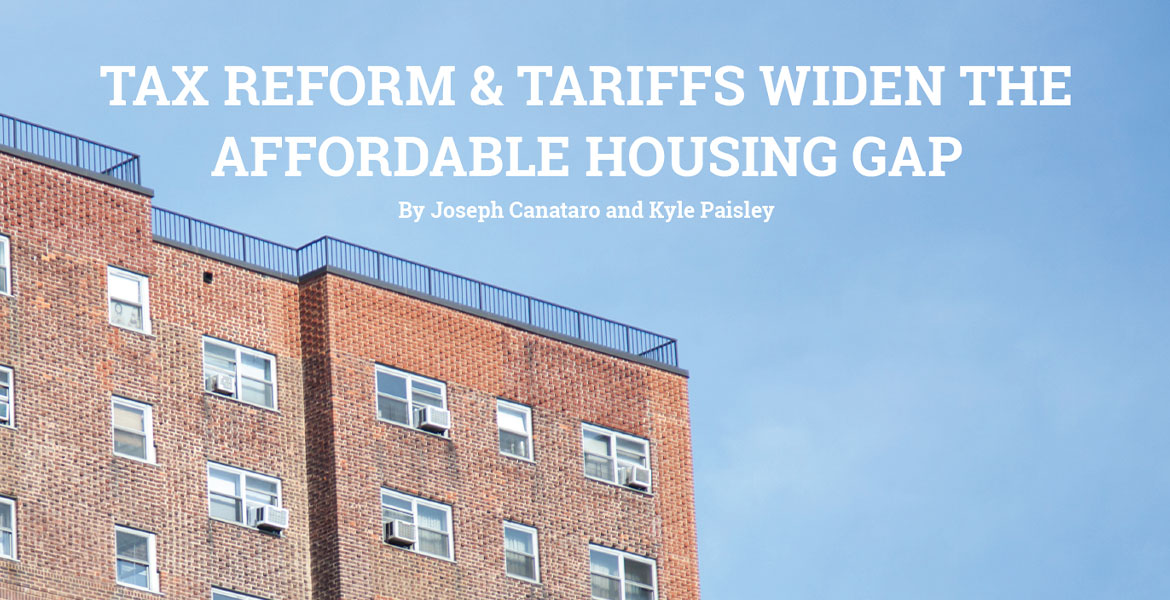The U.S. has an affordable housing gap, and the combined impact of tax reform and tariffs could make it a lot worse. What’s the scope of the current supply gap? The National Low Income Housing Coalition reports a shortage of 7.2 million affordable and available rental homes. This means that there are only 35 available units for every 100 extremely low-income renters (ELI). A household is characterized as ELI when their income is at or below the poverty guideline or 30 percent of their area median income (AMI). While the severity of the supply shortage varies greatly by state, the housing affordability gap stretches nationwide.
WHAT’S TAXING THE AFFORDABLE HOUSING MARKET?
Last year’s federal tax overhaul is the largest factor projected to negatively impact affordable housing development. The reduced corporate tax rate from 35 to 21 percent lowered the value of low-income housing tax credit (LIHTC) investments. Housing experts initially estimated tax reform could cut the growth of the affordable housing market by more than 230,000 units over the next decade.
While the reduced corporate tax rate has the most direct impact on LIHTC, it’s not the only tax change affordable housing developers are watching. The current tax code reduces the alternative depreciation system (ADS) cost recovery period for residential rental property from 40 to 30 years. Most LIHTC partnerships will elect under Section 163(j)(7)(B) to use the real property trade or business exception to the net business interest expense limitation. This election requires the use of ADS instead of the MACRS depreciation method, which has a useful life of 27.5 years for residential rental property.
With the one-year anniversary of the new tax law fast approaching, how has the affordable housing market shifted? Shortly after the 2016 presidential election, LIHTC pricing trends began their first sharp decline in anticipation of a reduced corporate tax rate. Pricing trends have stabilized and remained steady since March 2017, with average pricing fluctuating between 91 cents and 93 cents per LIHTC. Prior to the election, pricing was at a high over $1 per LIHTC. The reduction in LIHTC pricing increases need for other financing and funding from federal, state and local programs to support future affordable housing development.
TRADE DISPUTES ABROAD RAISE SUPPLY COSTS AT HOME
In addition to tax changes, affordable housing developers also face increased construction costs of future affordable housing projects and those already in development. The price of lumber, steel and aluminum—all essential building materials—climbed steadily as a result of the ongoing trade disputes.
The cost of 1,000-feet of western Canadian lumber in June was up nearly 80 percent over the past 12 months, according to data from trade publication Random Lengths. Lumber prices first started rising in October 2015, when a decade-old softwood lumber agreement between the United States and Canada expired without a replacement. The Trump administration’s 20 percent tariff on Canadian lumber accelerated the commodity’s price hike. An overall reduction in the supply of Canadian lumber due to rail slowdowns and tree disease have also contributed to the cost increases.
After this summer’s record highs, lumber prices have started to settle. There is renewed hope that the U.S. and Canada can reach a new softwood agreement as well. U.S. and Canada trade relations are showing signs of improvement, with a tentative agreement to replace NAFTA with the United-States-Mexico-Canada Agreement (USMCA) in motion. Progress in NAFTA renegotiations have renewed hope that the United States and Canada could also reach a new agreement on softwood lumber trade agreement.
The United States also began imposing tariffs on imported steel and aluminum of 25 percent and 10 percent, respectively. Construction costs are expected to rise modestly as a result, particularly for the development of high-rise assets that require far more steel and aluminum than multi-family townhouses. Trade tensions may be easing in North America, but the outlook for global trade relations remains uncertain. For affordable housing developers, the question remains: Will the trade disputes reach a resolution, or are the tariffs here to stay?
LEGISLATIVE BRIGHT SPOTS FOR AFFORDABLE HOUSING
The future is not all doom and gloom, however. Congress has already taken measures to address affordable housing advocates and developers’ concerns. In March 2018, Congress increased the LIHTC volume cap by 12.5 percent with the passage of The Consolidated Appropriations Act of 2018. The four-year temporary volume cap increase does not fully mitigate the impact of tax reform on affordable rental housing development and supply, but it does improve the outlook.
The March 2018 Act also included a new income-averaging set-aside option for LIHTC properties. Under the new option, income and rent limits for at least 40 percent of the units must average 60 percent or less. The new legislation will assist an owner’s ability to offset lower rental revenues where certain funding sources may require lower set-aside for a number of rental units with greater rental revenues from units at 70 or 80 percent AMI. The change will also provide relief to owners that are acquiring new affordable housing developments or rehabilitating existing properties where certain units could be ‘over income.’
CHANGES STILL AHEAD
The affordable housing sector has several other policy changes on their wish list. There are bipartisan efforts in Congress to go beyond the 12.5 percent increase in volume cap allocated federal LIHTCs passed this March and obtain a 50 percent increase. Additionally, there are appeals to establish a minimum 4 percent rate for LIHTC used to finance acquisitions and bond-financed developments.
If enacted, both changes would improve the outlook for the development of new affordable housing units. As the market currently stands, the fallout from tax reform and tariffs still present a considerable barrier for new developments. With increased construction costs and a tax code that makes LIHTC investments less attractive, 2019 will not be the year the U.S. bridges its affordable housing supply gap.
This article originally appeared in BDO USA, LLP’s “REC Monitor” newsletter (Winter 2019). Copyright © 2019 BDO USA, LLP. All rights reserved. www.bdo.com.


